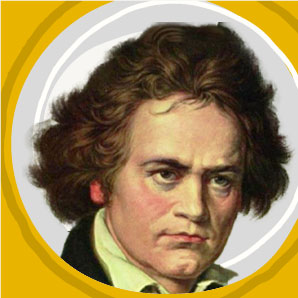Ludwig van Beethoven Biography - A Very Quick Guide
Artist:
Ludwig van Beethoven
Born:
15/16 December 1770, Bonn
Died:
26 March 1827, Vienna
Who was Ludwig van Beethoven?
German composer Ludwig van Beethoven was born in Bonn in December 1770, then part of the Electorate of Cologne. His grandfather had been Kapellmeister at the court in Bonn, and his father, Johann, was a singer and musician. His mother, Maria Magdalena, came from a family of cooks and servants in the court household.
What was his early life like?
Beethoven’s upbringing was difficult. His father’s strictness and alcoholism made home life unstable. At 17, Beethoven travelled to Vienna, where he briefly met Mozart, but returned home shortly after due to his mother’s illness and eventual death. In 1792, he returned to Vienna for good, this time to study with Joseph Haydn.
How did he survive after moving to Vienna?
Beethoven supported himself through public performances, private lessons, and the patronage of noble families such as the Lichnowskys and the Archduke Rudolph. These aristocratic supporters valued him for his genius but also respected his independence—a rarity at the time. Unlike many composers before him, Beethoven never held a permanent court position, instead working freelance and retaining full ownership of his music.
What types of music did he write?
Beethoven wrote in almost every major musical genre of his time. His works include:
9 symphonies
32 piano sonatas
5 piano concertos
16 string quartets
1 opera (Fidelio)
2 masses
numerous other chamber, choral, and solo piano works.
His music is often divided into three periods:
Early period (to 1802) – influenced by Haydn and Mozart, classical in form.
Middle period (1803–1814) – bold, dramatic, and expansive; includes the Eroica Symphony and Appassionata Sonata.
Late period (1815–1827) – introspective and highly original, including the Ninth Symphony and Late Quartets.
What was unusual about his life?
Beethoven’s hearing began to deteriorate in his late twenties, and by his mid-forties he was almost completely deaf. Despite this, he continued to compose and conduct. His inability to hear did not end his creativity; in fact, some of his most important works were written after total deafness had set in. He communicated with visitors through “conversation books,” many of which still survive.
What are his greatest works?
Some of Beethoven’s most celebrated compositions include:
Symphonies: Nos. 3 (Eroica), 5, 6 (Pastoral), and 9 (Choral)
Concertos: Piano Concertos Nos. 4 and 5 (Emperor), Violin Concerto in D major
Piano Sonatas: Pathétique, Moonlight, Waldstein, Appassionata, Hammerklavier
Chamber Music: String Quartet No. 14 in C-sharp minor, Op. 131
Vocal/Choral: Missa solemnis, Fidelio (opera)
Why is his personality so famous?
Beethoven was known for his strong will, irregular temper, and dishevelled appearance. He was prone to mood swings and bouts of depression.
How did Beethoven die?
Beethoven died in Vienna on March 26th, 1827, aged 56. The cause was likely liver disease, possibly worsened by heavy alcohol use and medical treatments of the time. His funeral was attended by thousands, and he was buried in the Währing cemetery (later reinterred in Vienna’s Central Cemetery).
Useful resources:
Wikipedia — Ludwig van Beethoven
Encyclopaedia Britannica — Ludwig van Beethoven | Biography, Compositions, & Facts
Beethoven-Haus Bonn — Official Museum and Archive
Classic FM — Who was Beethoven?
8notes Collection — Free Beethoven Sheet Music
German composer Ludwig van Beethoven was born in Bonn in December 1770, then part of the Electorate of Cologne. His grandfather had been Kapellmeister at the court in Bonn, and his father, Johann, was a singer and musician. His mother, Maria Magdalena, came from a family of cooks and servants in the court household.
What was his early life like?
Beethoven’s upbringing was difficult. His father’s strictness and alcoholism made home life unstable. At 17, Beethoven travelled to Vienna, where he briefly met Mozart, but returned home shortly after due to his mother’s illness and eventual death. In 1792, he returned to Vienna for good, this time to study with Joseph Haydn.
How did he survive after moving to Vienna?
Beethoven supported himself through public performances, private lessons, and the patronage of noble families such as the Lichnowskys and the Archduke Rudolph. These aristocratic supporters valued him for his genius but also respected his independence—a rarity at the time. Unlike many composers before him, Beethoven never held a permanent court position, instead working freelance and retaining full ownership of his music.
What types of music did he write?
Beethoven wrote in almost every major musical genre of his time. His works include:
His music is often divided into three periods:
What was unusual about his life?
Beethoven’s hearing began to deteriorate in his late twenties, and by his mid-forties he was almost completely deaf. Despite this, he continued to compose and conduct. His inability to hear did not end his creativity; in fact, some of his most important works were written after total deafness had set in. He communicated with visitors through “conversation books,” many of which still survive.
What are his greatest works?
Some of Beethoven’s most celebrated compositions include:
Why is his personality so famous?
Beethoven was known for his strong will, irregular temper, and dishevelled appearance. He was prone to mood swings and bouts of depression.
How did Beethoven die?
Beethoven died in Vienna on March 26th, 1827, aged 56. The cause was likely liver disease, possibly worsened by heavy alcohol use and medical treatments of the time. His funeral was attended by thousands, and he was buried in the Währing cemetery (later reinterred in Vienna’s Central Cemetery).
Useful resources:
Wikipedia — Ludwig van Beethoven
Encyclopaedia Britannica — Ludwig van Beethoven | Biography, Compositions, & Facts
Beethoven-Haus Bonn — Official Museum and Archive
Classic FM — Who was Beethoven?
8notes Collection — Free Beethoven Sheet Music
Top Pieces on 8notes by Ludwig van Beethoven
